Death Disrespected: The Trials and Tribulations of Santa Muerte Internacional and the Martyrdom of Comandante Pantera
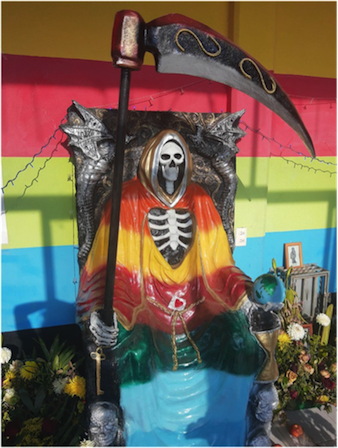
Death Disrespected: The Trials and Tribulations of S
Kate Kingsbury
On 6 May 2021, three heavily armed men stormed into the Santa Muerte temple known as Santa Muerte Internacional Tultitlán (SMI Tultitlán), firing off shots into the air. The men, who had previously attacked the home of Enriqueta Vargas, the former leader of the temple, looted the shrine for items of worth and beat up staff members. On SMI’s social media page, the owner of the temple, Kristhel Legaria Vargas, identified them as members of the Mendoza family, decrying them for raiding SMI for a “few pesos.” She lamented that she was forced to close the shrine[1] and dismiss the personnel stating, “because of these men, many people have lost their job and many others their place of worship.” She also affirmed that though the crime had been reported to the police, that no outcome was expected as “we all know how Mexico is. Everything is Corrupt.” Angry devotees reacted in horror. Some offered to install a heavy iron door and a barbed wire fence. Others promised to provide protection for the temple and many petitioned Santa Muerte for vengeance upon these men whose photos were widely circulated on social media. Kristel Legaria has opened the temple’s doors once again, but the vicious assault depicts how in Mexico, everyone may be subject to brutality and for delinquents nothing is sacred, not even death.[2]
Santa Muerte: A New Religious Movement
Santa Muerte is the fastest growing new religious movement (NRM) in the Americas with an estimated 10-12 million followers.[3] The NRM originated in Mexico. Santa means a female saint, as well as Holy. Muertemeans death. In English the folk saint is sometimes known as Holy Death or Saint Death. In her iconography—visible in statues, and other religious paraphernalia—she resembles the figure Britons and anglophones call the Grim Reaper. Followers pray to the skeleton saint for miracles of all kinds, for health and wealth, love and legal matters, as well as for protection against violence and dangers. They work brujeria (witchcraft), including to hex their enemies and to defend themselves from their ill intentions. Above all, while in many religions deities are supplicated to avoid demise, in Santa Muerte theology, while devotees might petition the Skeleton Saint to extend their life, if Holy Death comes to reap their soul, there is acceptance. It is understood, as a devotee told me, that “lo unico seguro que hay es la muerte” (the only thing that is certain is death)[4] and that furthermore, as the maxim states, “la vida es solamente un paso a la muerte” (life is only a path to death).[5]

Santa Muerte statue in a shrine in Oaxaca, photo by Kate Kingsbury, January 2020.
Santa Muerte has devotees among a varied demographic, ranging from lawyers to labourers and nurses to narcos. Nevertheless, most of the folk saint’s faithful hail from marginalized populations. They are people to paraphrase Achilles Mbembe “for whom living means continually standing up to death.”[6] Giorgio Agamben coined the term “bare life” to describe a situation whereby human life is unprotected and constantly exposed to death.[7] This, he explains, takes place when the indiscernibility of law contributes to a normative crisis where humans can be subjected to violence and killed with no consequences. As Mexican peace scholar Pietro Ameglio Patelli has pointed out, in Mexico those who do not belong to the ruling classes have been reduced to bare life: “that is to say unprotected life … of a being that can be subjected to violence, kidnapped, ill-treated or humiliated and murdered with impunity.”[8]
Many of Santa Muerte’s devotees belong to groups who stare death in the face daily, not only as they pray before the skeletal figure of Santa Muerte but due to the fragility of their existences. Some are narcos, sicarios and other delinquents whose nefarious activities mean they live on the knife’s edge of life flaunting the law and facing continuous threats from rival gangs or the police. Some are members of law enforcement. Nevertheless, many devotees are not cartel members nor police but everyday citizens who live in places imperiled by drug violence, and are witnesses to, or victims of, homicides and femicides among their family, friends and neighbors. They also must cope with poverty, hunger and disease in the post-colony of Mexico where those in power cannot be relied upon to guarantee basic human rights, least of all ensure safety for their citizens. In such circumstances, no matter what side of the law they are on, for Santa Muerte’s faithful, the folk saint of death is imagined as offering supernatural aegis from these constant threats and a few more days of life. And should death come, devotees feel prepared as much is possible. As a devotee related to me: “I have had discussions with la Santa and told her that if it is my time she can reap my soul, but I hope that she will let me live another day.”
Another facet crucial to understanding the appeal of Santa Muerte to devotees, is that death does not judge. Death comes to us all, no matter our origins, socio-economic status, skin color, or vocation. The affluent necessarily have superior odds of survival. They possess the funds necessary to pay for protection—whether in the form of security personnel or surveillance equipment. They have access to the best medical care that money can buy. Nevertheless, they cannot escape death’s bony clutches. As death comes to us all without any differentiation, the folk saint is perceived as being amoral and listening to petitions of any type from people of all walks of life. In contradistinction, the Catholic Church in Mexico is a relatively exclusionary faith. Led by highly educated men with specific theological training, the Church does not give leadership positions to anyone, nor welcome all congregants, discriminating, for example, on the basis of sexual orientation or profession. This is why it is said that narcos are particularly drawn to Santa Muerte, given her amorality, as she is said to honor all petitions. Nevertheless, it should be noted that some of the most notorious narcos identify as Catholic and not as devotees of Santa Muerte, such as Joaquín “El Chapo” Guzmán.
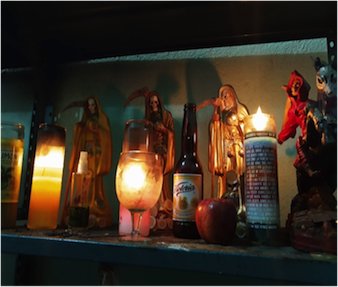
Altar to Santa Muerte at the back of a Mexican Store, photo by Kate Kingsbury, December 2019.
The Mexican state apparatus is likewise exclusionary. Under the leadership of the educated elite, it is run by those whose lives bear scant similarity to the average Mexican’s. Not infrequently the resources and networks it offers benefit those within it as opposed to those outside the institution. Having done fieldwork in the post-colonies of Mali and Senegal, prior to working in Mexico, I note that the Mexican state, much as in those countries serves “as the basis of dominant-class formation: through its legitimate employment and expenditures; through its development plans and strategy; through the manipulation of patronage … ties to inhibit the development of lower-class consciousness and organization; and finally, through the illegitimate accumulation of public wealth, i.e., political corruption.”[9] In Mexico, the government comprises many figures who engage in what have been termed “narco-politics.”[10] that is to say lucrative accords with the leaders of drug cartels. Such activities ensure such officials glean financial benefits and other favors.[11]
As a loosely organized NRM with no restrictions on membership nor leadership, Santa Muerte distinguishes itself from Church and State. The folk saint of death is
The great majority of the folk saint’s followers have become devotees since 2001. This is when Enriqueta Romero Romero, known as Doña Queta—a once impoverished housewife who previously sold quesadillas out of her kitchen and went on to become a pioneering and powerful devotional leader—opened the first public shrine to Santa Muerte in Tepito, one of the most dangerous barrios of Mexico City. However, others became believers in the skeleton saint as of 2007 when SMI Tutitlán was founded under Jonathan Legaria Vargas, and many more converted under Enriqueta Vargas Ortiz, Legaria’s mother.
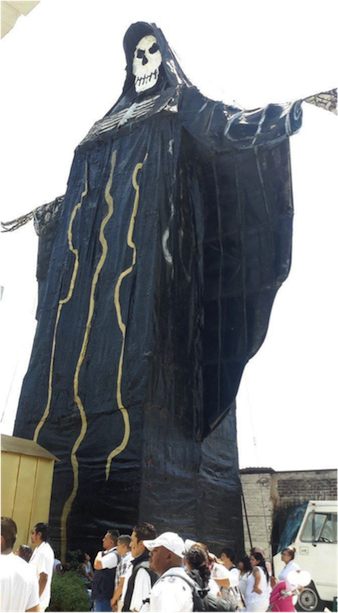
The 75-foot effigy of Santa Muerte erected by Jonathan Legaria Vargas. Photo courtesy of Andrew Chesnut, April 2014.
“Comandante Pantera”
In 2007, to thank Santa Muerte for her protection, 29-year-old Jonathan Legaria Vargas erected a towering 75-foot figure of the folk saint in Tultitlán,
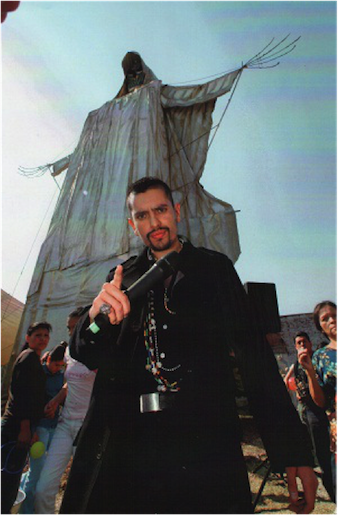
Jonathan Legaria Vargas, Photo courtesy of Kristhel Legaria, September 2007
While Legaria Vargas was involved in social outreach, unlike clergy and politicians many of whom have dirty hands but feign their innocence, he made no pretense of being a virtuous person. As a devotee told me: “he was no angel.” It was well-known that Comandante Pantera practiced black magic, conducting rituals for cartel members. Initiated into both
Additionally, it was well known that while not a drug
Legaria Vargas died as many Mexicans do, at the hands of assassins who would never be punished. In 2008, as he drove along Via Lopez
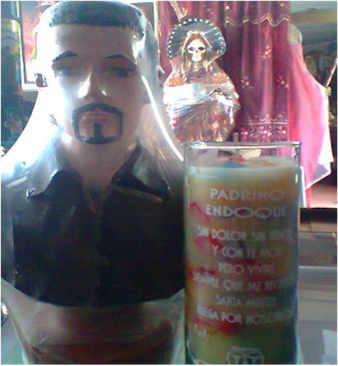
Statuette of Jonathan Legaria Vargas and Votive Candle featuring his name “Padrino Endoque” used for worship. Photo courtesy of Kristhel Legaria, 2 March 2021.
Since his death and martyrdom, Comandante Pantera has become an adjunct folk saint of Santa Muerte. San Padrino Endoque
Death in Mexico is not viewed in contradistinction to life. For many, and in particular for the working class, as is seen during Day of the
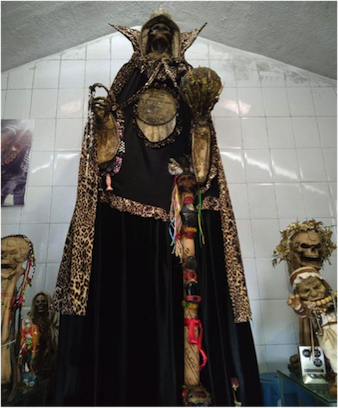
Santa Muerte statue at SMI temple ready to receive the spirit of Jonathan Legaria: the altar of the forever living. Photo taken on 30 July 2021 by Kristhel Legaria.
While a controversial figure, his fallibility, faith and premature, violent death struck a chord with many devotees. Folk saints, unlike Catholic saints, who have been canonized by the Church, are typically spirits of the deceased who have not obtained official recognition but are believed by the local populace to possess supernatural powers and be able to deliver miracles. Folk saints in Latin America have long been appealed to above Catholic saints. The great majority of the latter lived centuries ago in Europe. These Catholic figures are far removed from the average Latin American therefore they can be difficult to relate to, although Saint Jude, patron of lost causes, is hugely popular in Mexico.
Due to cultural affinities and familiar life stories, folk saints are perceived as being more likely to listen to, understand and resolve the problems of their followers.[18] As Frank Graziano details, devotees describe their folk saint as “a close friend and steadfast companion, as someone who is with them always, and with whom they converse, as many put it, ‘in the same way I’m talking to you.’”[19] Many talk to Pantera, and many more to Santa Muerte. The lives of folk saints are similar to those of local people, moreover they often die young, violently and tragically, in the context of corrupt and abusive authorities which they may have challenged.[20] Thus the circumstances surrounding Legaria Vargas’s life, and death have made him an idealized figure who easily morphed into a folk saint. However, whether devotion to him will be sustained across time and generations is
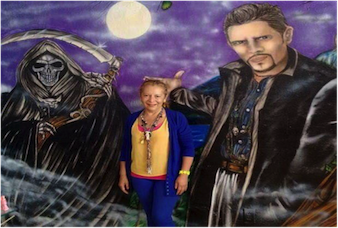
Enriqueta Vargas Ortiz, former leader of SMI. Photo courtesy of Kristel Legaria, November 2016.
Enriqueta Vargas: “La Madrina”
Legaria’s death led to Enriqueta Vargas Ortiz breathing new life into SMI. She was not a devotee of Santa Muerte like her son, and venerated the Virgin of Guadalupe. Nevertheless, at the time of his death she made a covenant with the skeleton saint. She vowed to extend Santa Muerte’s reputation if the saint brought justice to those that assassinated her son. Events following her entreaty unfolded such that Vargas believed that the saint of death had responded to her request. Vargas Ortiz made good on her promise. She expanded Santa Muerte Internacional (SMI) into a transnational network of temples and shrines spanning across the Americas built upon a robust global community of devotees interlinked via social media platforms. She became a major public spokesperson acquiring significant social status, spiritual prestige and financial capital. While in the Catholic Church women are not allowed to be priests and in politics one must
Arely Vazquez is the leader of SMI New York. As a transgender woman she found herself excluded from the Catholic Church
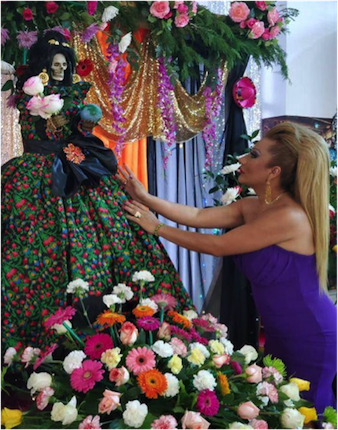
Arely Vazquez, leader of SMI New York. Photo courtesy of Arely Vazquez, September 2021.
Vazquez recalls Vargas fondly, not only as a motherly figure to her but in the public sphere “a driven, dedicated and intelligent woman” who with no experience went on to establish an international religious movement earning her the

Arely Vazquez honoring Enriqueta Vargas. Photo courtesy of Arely Vazquez, December 2020.
The Future of SMI Tultitlán?
When Vargas died in 2018 from cancer, her daughter Kristhel Legaria Vargas took over leadership of SMI and continues her mother’s work. Vazquez explained to me that Kristhel, trained as a lawyer, and much like her mother, had a steep learning curve. In honor of her mother and brother’s memory she continues to keep the traditions established by them. Every Sunday services are held which Kristhel brings her own touch to.
Vazquez related to me that since the death of Enriqueta Vargas sadly SMI Tultilán has been plagued by violence. Firstly, Kristhel Legaria Vargas’s house was invaded by armed robbers. Despite complaints to the police the criminals were not caught. Moreover, the temple itself was later sacked. According to Arely, the delinquents stole many items and sought to assassinate Ana Laura Legaria Vargas, Kristhel’s sister. What is all the more sinister is that the criminals were aware of the layout of the temple and immediately identified items of value. I asked Vazquez if the delinquents were not afraid of the wrath of Santa Muerte, who is well known to have a vengeful side. She replied that in Mexico “some people clearly cannot even respect Death.”
Due to the violent attack, Kristhel and her sister decided to shut the temple indefinitely and for months it stood in abeyance. Such was the public outcry from devotees and the support of leaders across the country that the temple was later reopened, fervent followers and founders of other shrines offering their protection and aegis to SMI. With security tripled, every Sunday services are held once more at a temple whose very history is rooted in the violence of Mexico which has conjoined both leaders and devotees of the temple from its inception. Bowed together silently in prayer to worship the folk saint of Death, and to honor those who have died—whether from unnatural causes such as Jonathan Legaria Vargas or natural causes, such as his mother Enriqueta Vargas Ortiz—devotees of death at SMI Tultitlan are in many ways a tableau vivant of how death looms larger than life in Mexico City. The future of SMI Tultitlán remains uncertain, but for now the unity of devotees who worship death, the only “deity” fitting in a space of hyperviolence, keeps the temple alive.
Endnotes
[1] AndrewChesnut1 (@Dr. Death & Divinity) “Santa Muerte Internacional in Tultitlan dismisses staff and shuts down after second armed robbery.” Twitter. 6 May 2021, https://twitter.com/andrewchesnut1/status/1390261363377942528?s=27. See also Smi Templo, “Lamento dar esta noticia, se cierra el templo definitivamente, por culpa de estas personas que por segunda vez le faltaron al respeto a nuestra madre y a sus devotos, el dia de hoy entraron con armas y dispararon, solo por que querían unos pesos. Por su culpa se quedan sin trabajo muchas personas y sin un lugar de fe miles de devotos… (Regret to give this news, the temple is definitely closed, for the guilt of these people who for the second time missed respect to our mother and her devotes, today they went in with guns and shot, just because they wanted a few weights. Because of his blame are left without work many people and a place of faith thousands of devotees).” Facebook. 5 May 2021, https://www.facebook.com/smi.smi.169067/posts/463382881387162.
[2] See Smi Templo, Facebook. Multiple dates, https://www.facebook.com/smi.smi.169067; and https://fb.watch/8emQK89wco/ for background.
[3] R. Andrew Chesnut, Devoted to Death: Santa Muerte, The Skeleton Saint. New York: Oxford University Press. 2017, p.12.
[4] Kate Kingsbury, “Death is Women’s Work: The Female Followers of Santa Muerte.” International Journal of Latin American Religions. Vol. 5, no. 2. 2021: pp.1–23. 2021, https://doi.org/10.1007/s41603-020-00106-2.
[5] Kate Kingsbury, “Doctor Death and Coronavirus: Supplicating Santa Muerte for Holy Healing.” Anthropologica. Vol. 63, no. 1. 2021: pp.1-23. 2021, https://doi.org/10.18357/anthropologica6312021357.
[6] Achilles Mbembe, Necropolitics. Durham: Duke University Press. 2019, pp. 36–38.
[7] Giorgio Agamben, Homo Sacer: Sovereign Power and Bare Life. Palo Alto: Stanford University Press, 1998.
[8] See Claire Schaeffer-Duffy, “Peace scholar says finding disappeared victims of Mexico’s drug war ‘a moral issue.’” National Catholic Reporter. 30 January 2020, https://www.ncronline.org/news/justice/peace-scholar-says-finding-disappeared-victims-mexicos-drug-war-moral-issue.
[9] Larry Diamond, “Class Formation in the Swollen African State.” The Journal of Modern African Studies. Vol. 25, no. 44. December 1987: pp.567-596, https://doi.org/10.1017/S0022278X00010107.
[10] Silviana Patenostro, “Mexico as a Narco-Democracy. World Politics Journal. Vol. 12, no. 1. Spring 1995: pp. 41-47 at p. 42, available at https://www.jstor.org/stable/40209397.
[11] Peter Andreas, “The Political Economy of Narco-Corruption in Mexico.” Current History. Vol. 97. April 1998, p. 160.
[12] Op. cit., Chesnut at Note 3, p.125.
[13] R. Andrew Chesnut and David Metcalf, “Holy Death: Santa Muerte, Day of the Dead and La Catrina.” HuffPost.15 October 2015, https://www.huffpost.com/entry/holy-death-santa-muerte-d_b_8305040.
[14] Jonathan Legaria Vargas, Santisima Muerte Revelaciones. Chimalhuacan, Mexico: Ediciones Aigam, 2007.
[15] Op. cit., Chesnut at Note 3, p. 126
[16] Kate Kingsbury, “The Knights Templar Narcotheology: Deciphering the Occult of a Narcocult.” Chapter 10 in Robert J. Bunker and Alma Keshawarz, Eds., Los Caballeros Templarios de Michoacán: Imagery, Symbolism, and Narratives. (Small Wars Journal–El Centro eBook). Bethesda: Small Wars Foundation. April 2019: pp. 89-100, https://www.academia.edu/38806893/Los_Caballeros_Templarios_de_Michoacán_Imagery_Symbolism_and_Narratives.
[17] Kristen Norget, Days of Death, Days of Life: Ritual in the Popular Culture of Oaxaca. New York: Columbia University Press, 2006.
[18] Kate Kingsbury and Andrew Chesnut, “Not Just a Narcosaint: Santa Muerte as Matron Saint of the Mexican Drug War.” International Journal of Latin American Religions. Vol. 4, no. 1. 2020, pp. 25-47, https://link.springer.com/article/10.1007%2Fs41603-020-00095-2; and Op. cit. Kingsbury at Note 4.
[19] Frank Graziano, Cultures of Devotion: Folk Saints of Spanish America. Oxford: Oxford University Press. 2006, p. 6.
[20] Ibid.
[21] Op. cit., Kingsbury at Note 4.
[22] Enriqueta Vargas Ortiz, ¿Quién mató al Comandante Pantera? Mexico, 2012.






